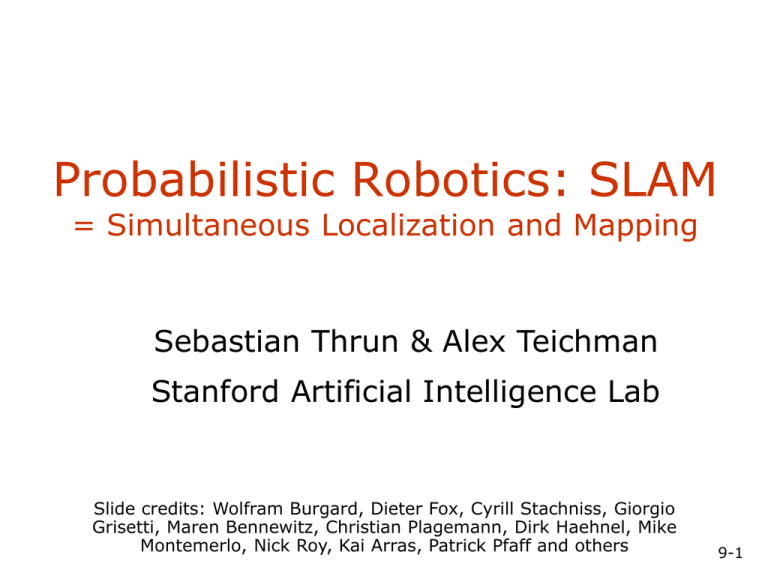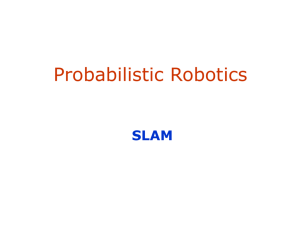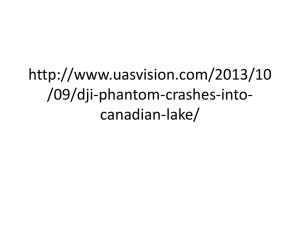SLAM
advertisement

Probabilistic Robotics: SLAM = Simultaneous Localization and Mapping Sebastian Thrun & Alex Teichman Stanford Artificial Intelligence Lab Slide credits: Wolfram Burgard, Dieter Fox, Cyrill Stachniss, Giorgio Grisetti, Maren Bennewitz, Christian Plagemann, Dirk Haehnel, Mike Montemerlo, Nick Roy, Kai Arras, Patrick Pfaff and others SA-1 9-1 The SLAM Problem A robot is exploring an unknown, static environment. Given: • The robot’s controls • Observations of nearby features Estimate: • Map of features • Path of the robot 9-2 Chicken-or-Egg • SLAM is a chicken-or-egg problem • A map is needed for localizing a robot • A good pose estimate is needed to build a map • Thus, SLAM is regarded as a hard problem • • in robotics A variety of different approaches to address the SLAM problem have been presented Probabilistic methods outperform most other techniques 9-3 Structure of the Landmarkbased SLAM-Problem 9-4 SLAM Applications Indoors Undersea Space Underground 9-5 Map Representations Examples: City map, subway map, landmark-based map 9-6 Map Representations • Grid maps or scans [Lu & Milios, 97; Gutmann, 98: Thrun 98; Burgard, 99; Konolige & Gutmann, 00; Thrun, 00; Arras, 99; Haehnel, 01;…] • Landmark-based [Leonard et al., 98; Castelanos et al., 99: Dissanayake et al., 2001; Montemerlo et al., 2002;… 9-7 Why is SLAM a hard problem? SLAM: robot path and map are both unknown Robot path error correlates errors in the map 9-8 Why is SLAM a hard problem? Robot pose uncertainty • In the real world, the mapping between • • observations and landmarks is unknown Picking wrong data associations can have catastrophic consequences Pose error correlates data associations 9-9 SLAM: Simultaneous Localization and Mapping • Full SLAM: Estimates entire path and map! p( x1:t , m | z1:t , u1:t ) • Online SLAM: p ( xt , m | z1:t , u1:t ) p ( x1:t , m | z1:t , u1:t ) dx1dx 2 ...dxt 1 Integrations typically done one at a time Estimates most recent pose and map! 9-10 Graphical Model of Full SLAM: p( x1:t , m | z1:t , u1:t ) 9-11 Graphical Model of Online SLAM: p( xt , m | z1:t , u1:t ) p( x1:t , m | z1:t , u1:t ) dx1 dx2 ...dxt 1 9-12 Techniques for Generating Consistent Maps • Scan matching • EKF SLAM • FastSLAM • Probabilistic mapping with a single map and a posterior about poses Mapping + Localization • GraphSLAM, SEIF 9-13 Kalman Filter Algorithm 1. Algorithm Kalman_filter( mt-1, St-1, ut, zt): 2. 3. 4. Prediction: m t At mt 1 Bt ut St At St 1 AtT Rt 5. 6. 7. 8. Correction: Kt St CtT (Ct St CtT Qt )1 mt m t Kt ( zt Ct m t ) St (I Kt Ct )St 9. Return mt, St 9-14 (E)KF-SLAM • Map with N landmarks:(3+2N)-dimensional Gaussian Bel( xt , mt ) x y l1 , l 2 lN x2 xy x xl1 xl2 xl N xy y2 y yl1 yl2 ylN x y 2 l1 l2 lN xl1 yl1 l1 l21 l1l2 l1lN xl2 yl2 l2 l1l2 l22 l2l N xlN ylN lN l1lN l2l N 2 lN • Can handle hundreds of dimensions 9-15 EKF-SLAM Map Correlation matrix 9-16 EKF-SLAM Map Correlation matrix 9-17 EKF-SLAM Map Correlation matrix 9-18 Properties of KF-SLAM (Linear Case) [Dissanayake et al., 2001] Theorem: The determinant of any sub-matrix of the map covariance matrix decreases monotonically as successive observations are made. Theorem: In the limit the landmark estimates become fully correlated 9-19 Victoria Park Data Set [courtesy by E. Nebot] 9-20 Victoria Park Data Set Vehicle [courtesy by E. Nebot] 9-21 Data Acquisition [courtesy by E. Nebot] 9-22 Raw Odometry (no SLAM) GPS (for reference) Odometry 9-23 Estimated Trajectory [courtesy by E. Nebot] 9-24 EKF SLAM Application [courtesy by J. Leonard] 9-25 EKF SLAM Application odometry estimated trajectory [courtesy by John Leonard] 9-26 Approximations for SLAM • Local submaps [Leonard et al.99, Bosse et al. 02, Newman et al. 03] • Sparse links (correlations) [Lu & Milios 97, Guivant & Nebot 01] • Sparse extended information filters [Frese et al. 01, Thrun et al. 02] • Thin junction tree filters [Paskin 03] • Rao-Blackwellisation (FastSLAM) [Murphy 99, Montemerlo et al. 02, Eliazar et al. 03, Haehnel et al. 03] 9-27 EKF-SLAM: Complexity • Cost per step: O(n2), quadratic in the number of landmarks: O(n2) • Total cost to build a map with n landmarks: O(n3) • Memory: O(n2) Approaches exist that make EKF-SLAM O(n^1.5) / O(n2.5) / O(n) 9-28 EKF-SLAM: Summary • Convergence for linear case! • Can diverge if nonlinearities are large • Has been applied successfully in large-scale environments • Approximations reduce the computational complexity 9-29 Data Association for SLAM Interpretation tree 9-30 Data Association for SLAM Env. Dyn. 9-31 Data Association for SLAM Geometric Constraints Location independent constraints Unary constraint: intrinsic property of feature e.g. type, color, size Binary constraint: relative measure between features e.g. relative position, angle Location dependent constraints Rigidity constraint: "is the feature where I expect it given my position?" Visibility constraint: "is the feature visible from my position?" Extension constraint: "do the features overlap at my position?" All decisions on a significance level 9-32 Data Association for SLAM Interpretation Tree [Grimson 1987], [Drumheller 1987], [Castellanos 1996], [Lim 2000] Algorithm • backtracking • depth-first • recursive • uses geometric constraints • exponential complexity • absence of feature: no info. • presence of feature: info. perhaps 9-33 Data Association for EKF SLAM Pygmalion a = 0.95 , p = 2 9-34 Data Association for EKF SLAM Pygmalion a = 0.95 , p = 3 9-35 Data Association for EKF SLAM Pygmalion texe: 633 ms PowerPC at 300 MHz a = 0.95 , p = 4 a = 0.95 , p = 5 9-36 Summary: EKF SLAM • Extends EKF localization by additional state variables (landmark locations) • Converges in linear-Gaussian world • Data association problem: which measurement corresponds to which landmark? • Data association solved by tree search 9-37










